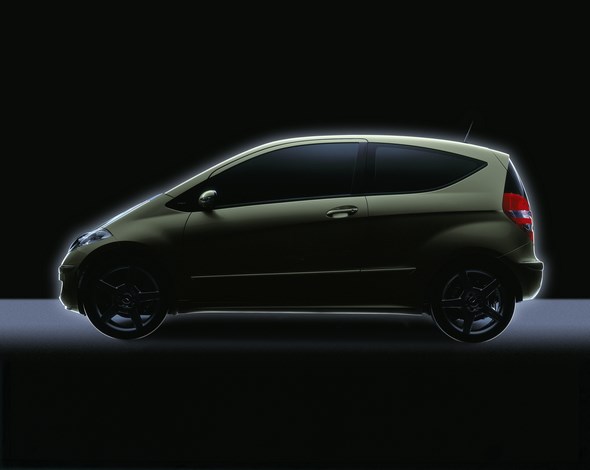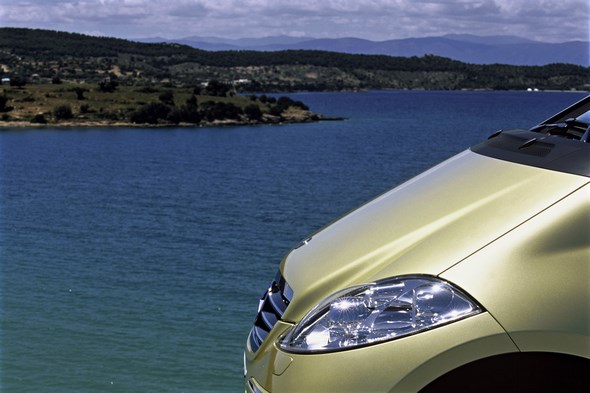Mercedes W169 A-Class 2005 – 2011

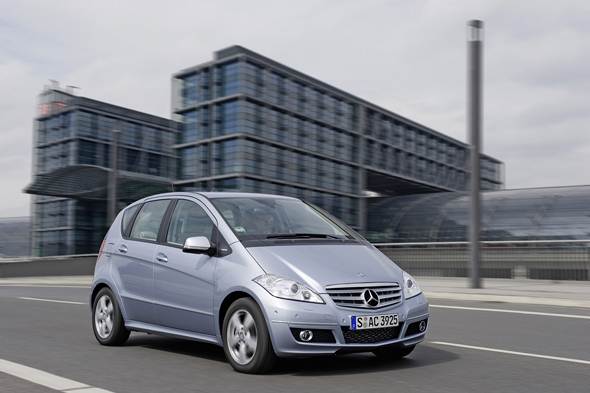
The A-Class once again sets the standards for safety, comfort and environmental protection
Stuttgart – With more than 500,000 units produced within three and a half years, the A-Class is among the bestsellers in the Mercedes-Benz passenger car range.
Now the latest generation of this compact car is showing itself to be more youthful, attractive and environmentally compatible than ever before.
This is ensured by a completely revised design, high-grade appointments and new technical developments which further improve safety, comfort and economy.
A convenient ECO start-stop function which reduces urban petrol consumption of these BlueEFFICIENCY vehicles by up to nine percent is now available for the high-volume models A 150 and A 170, for example.
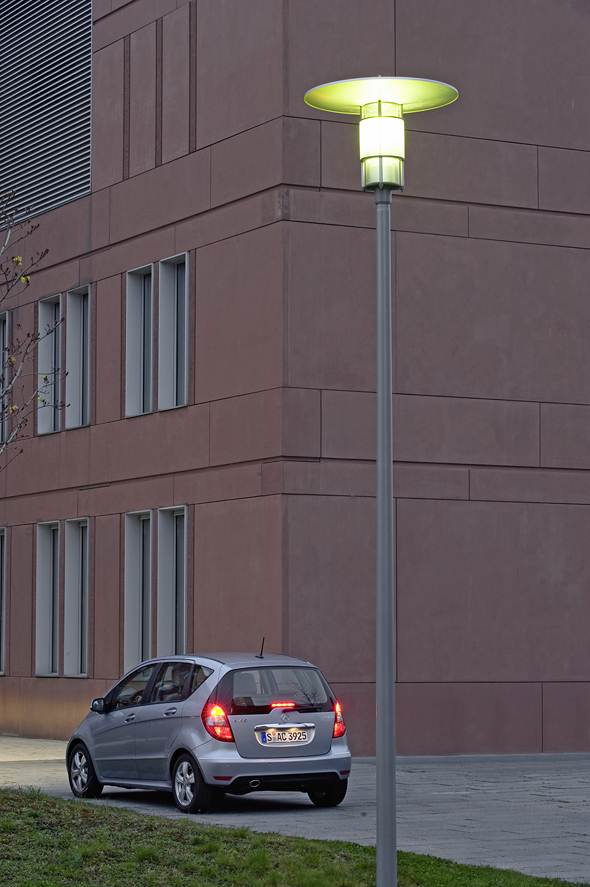
For the three-door A 160 CDI Mercedes-Benz has developed an additional BlueEFFICIENCY package which lowers the fuel consumption of the Coupé by more than eight percent, to 4.5 litres per 100 kilometres.
Independent experts have acknowledged these great advances in the environmental field with an internationally valid environmental certificate, which the A-Class is the world’s first compact car to achieve.
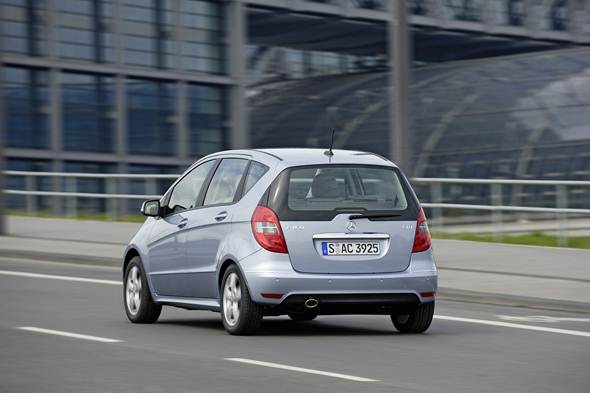
Since its world premiere in 1997, the A-Class has made a name for itself as a trendsetter and innovative leader in its class.
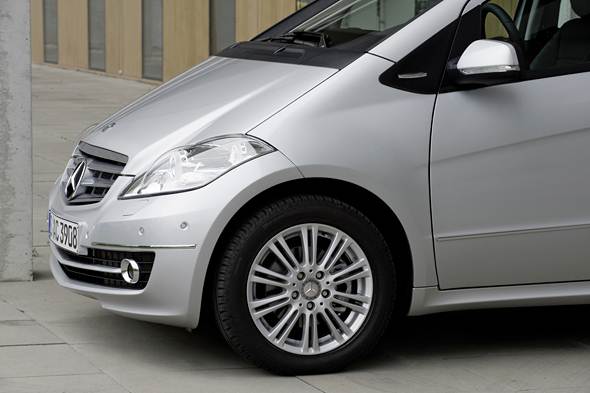
Outstanding safety, great day-to-day flexibility and reliability have always been among the strengths of the A-Class, which has so far captured the enthusiasm of about 1.7 million customers with its distinctive and versatile vehicle concept.

In spring 2008 Mercedes-Benz is presenting the five-door Saloon and the threedoor Coupé in completely upgraded versions.

Viewed from the front, this compact Mercedes-Benz now appears more youthful and self-confident than before.

The sweeping lines of the newly designed headlamps harmoniously combine the front end and flanks, which literally appear to be cast from a single mould.

The redesigned front bumper reinforces this impression; its lower air intake is now much larger, emphasising the width of the body.

The radiator grille is also in a new design which underlines the progressive aura of the A-Class.

Lines: ELEGANCE and AVANTGARDE with an even more pronounced styling emphasis
Design features at the front end provide more distinctions between the design and equipment lines of the A-Class.

While the louvres in the radiator grille of the basic version are painted in dark-grey, they are respectively in metallic atlas grey and high-sheen iridium silver in the ELEGANCE and AVANTGARDE lines, and are also visually upgraded by additional chrome strips.

Discreet chrome trim strips further reinforce this impression. In the AVANTGARDE line, the front bumper also has a distinctive design which emphasises the arrow-shape of the front end and suggests greater agility.
When viewed from the side the different lines in the A-Class are distinguished by wheel designs.
While the basic model is equipped with 15-inch wheels and seven-spoke wheel embellishers as standard, ELEGANCE and AVANTGARDE are fitted with individually designed 16-inch light-alloy wheels.

The new, larger exterior mirror housings and door handles are now painted in the vehicle colour for all model variants.
The previous side rubbing strips have been replaced by discreet chrome trim strips, which provide additional visual highlights in the ELEGANCE and AVANTGARDE models.
The rear end of the A-Class is dominated by a modified bumper and newly designed rear light clusters which extend well into the vehicle flanks. Both these features make the body appear wider and therefore more imposing.
In the ELEGANCE and AVANTGARDE models the rear bumper is embellished with additional, reflector-look trim strips and chrome inserts.
The new, ergonomically improved tailgate handle is chrome-plated in both lines, as is the oval exhaust tailpipe.
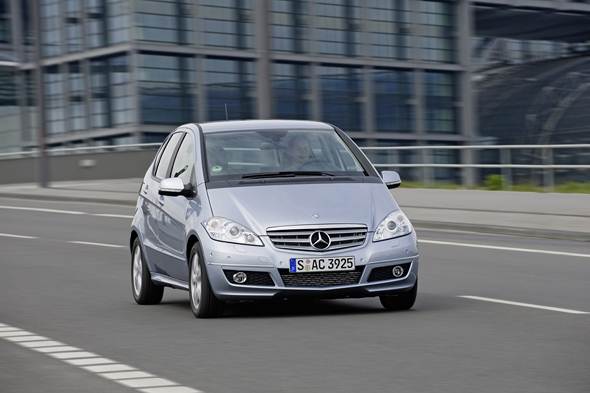
Interior: upgraded with larger stowage compartments and new fabrics
Mercedes designers paid particular attention to enhanced value when redesigning the interior, choosing new, high-grade upholstery fabrics and door linings.
In the ELEGANCE and AVANTGARDE lines the seats are upholstered in an attractive combination of ARTICO man-made leather and fabric, which is available in three colours.
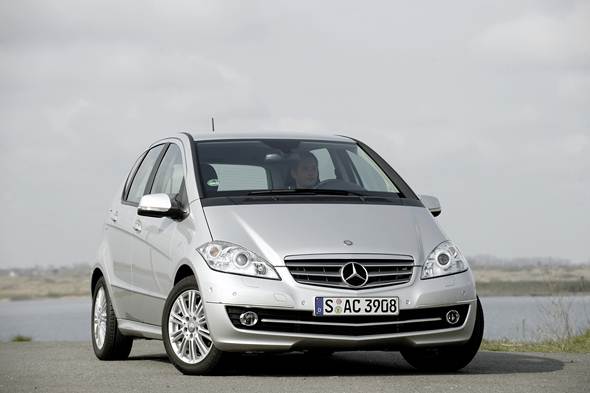
In addition new decorative trim of smoke-grey, diagonally brushed aluminium enhances the interior of the AVANTGARDE line, while the dignified aura of the ELEGANCE models is heightened by wood trim.
All variants of the A-Class share a larger stowage compartment in the centre console and a newly designed cupholder between the front seats.
The luxury seat package with seat cushion angle adjustment and lumbar support, seat height adjustment for the driver’s seat, a front armrest and a parcel net in the front passenger footwell is standard equipment for ELEGANCE and AVANTGARDE models.
Fuel economy: the A 160 CDI BlueEFFICIENCY consumes 4.5 litres
With fuel consumption figures between 4.9 and 8.1 litres per 100 kilometres, the new-generation A-Class is a model of fuel economy.

Thanks to detailed improvements, the fuel consumption of the state-of-the-art direct-injection diesel engines has been reduced by more than eight percent or 0.5 litres per 100 kilometres compared to the preceding series.

From autumn 2008 Mercedes-Benz will introduce a standard BlueEFFICIENCY package for the three-door A 160 CDI with a manual transmission, with further improvements in engine efficiency, aerodynamics, rolling resistance, energy management and weight.

The sum of these measures achieves a fuel saving of 0.4 litres, which means that the A 160 CDI BlueEFFICIENCY has an NEDC consumption of just 4.5 litres per 100 kilometres. As a result the CO2 emissions of the 60 kW/82 hp Coupé are 119 grams per kilometre.

The BlueEFFICIENCY package also includes an aerodynamically optimised radiator grille. This has a closed-off interior face to reduce the airflow to the engine, though the CDI engine is still cooled effectively at all times.

The suspension has also been lowered by ten millimetres to reduce the drag coefficient even further.
Mercedes engineers have exploited an additional fuel-saving potential by controlling the onboard power supply of the A 160 CDI BlueEFFICIENCY according to demand, and therefore on an energy-saving basis.

A sensor constantly monitors the battery so that the output of the generator can be reduced for certain periods when the battery is well charged.

This reduces the work required of the engine, which therefore consumes less fuel. To recharge the battery with optimum energy efficiency, the generator management system utilises the engine’s overrun phases to produce electrical energy.

Start-stop function: the engine switches off automatically when idling In the case of the petrol engines, Mercedes engineers have achieved NEDC fuel savings of up to 0.4 litres per 100 kilometres with a newly developed ECO startstop function.

From autumn 2008 this system will be available for the highvolume models A 150 and A 170 on request. It automatically switches off the engine when the driver shifts the manual transmission to neutral at a low speed while applying the brakes.

If the conditions for engine switch-off are met, the driver is informed by a special display in the instrument cluster.
Within fractions of a second, and almost noiselessly, the engine is restarted as soon as the clutch is operated or the brake released.
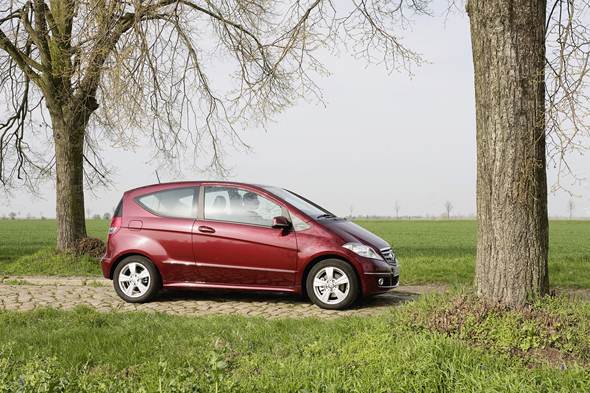
This rapid and comfortable engine start is a major advantage of the ECO start-stop function versus other systems of this kind.

To this end Mercedes-Benz uses a starter generator which is linked to the crankshaft via the drive belt. As a result the engine starts much more rapidly and quietly than with the conventional starter.
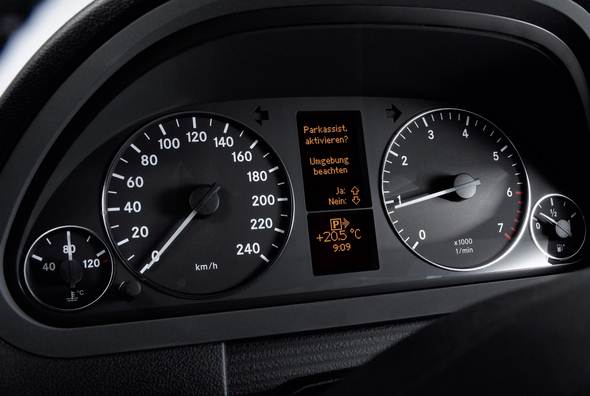
During a journey the starter generator feeds electrical power to the onboard network of the A-Class.
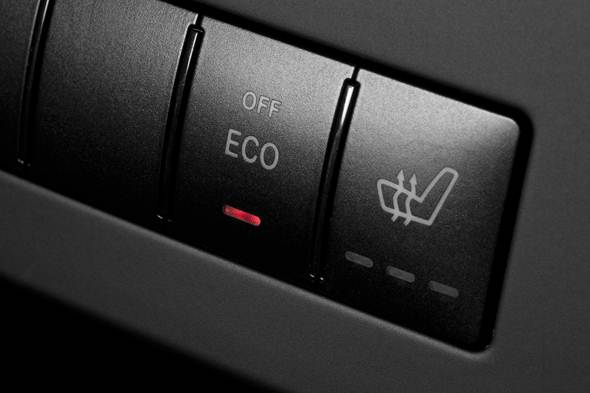
Economy: nine percent lower fuel consumption in city traffic
With the ECO start-stop function the NEDC fuel consumption is reduced by a further 6.5 percent or so. The A 150 BlueEFFICIENCY (70 kW/95 hp) absolves a measured test journey with a fuel consumption of 5.8 litres per 100 kilometres, which corresponds to 139 grams of carbon dioxide per kilometre.

Even greater advantages can be achieved in normal road traffic, as the results of extensive practical trials have confirmed: Mercedes employees tested the system in 175 test cars, covering a total of around 1.2 million kilometres.

Roughly half of this enormous mileage was covered in city traffic, where the new ECO start-stop function enabled fuel savings of up to nine percent to be achieved.

Ecology: the A-Class is the first compact car with an environmental certificate
Practical trials such as this are of immense importance to Mercedes-Benz when it comes to evaluating new technologies.

The environmental compatibility of vehicles is not only assessed on the basis of standardised emissions and fuel consumption measurement, but also taking into account the entire vehicle lifecycle – from production and many years of operation to eventual recycling and disposal.
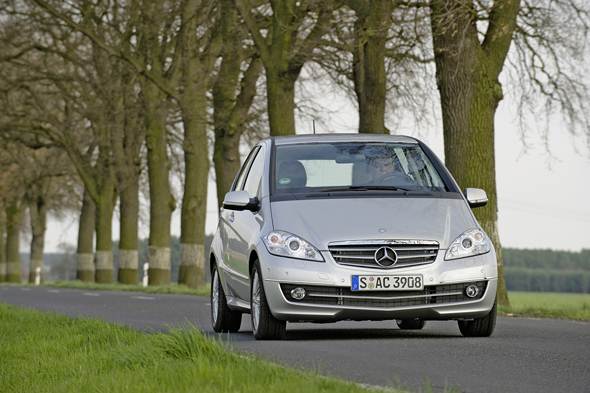
An analysis of more than 40,000 individual processes provides an overall picture and enables the development work to be objectively assessed.

This form of environmental audit is the basis of the environmental certificate according to the stringent international ISO standard 14062 (Design For Environment), which Mercedes-Benz is the world’s only automobile brand to have received.

This certificate also applies to the new-generation A-Class, confirming the considerable advances made in the field of environmental protection.
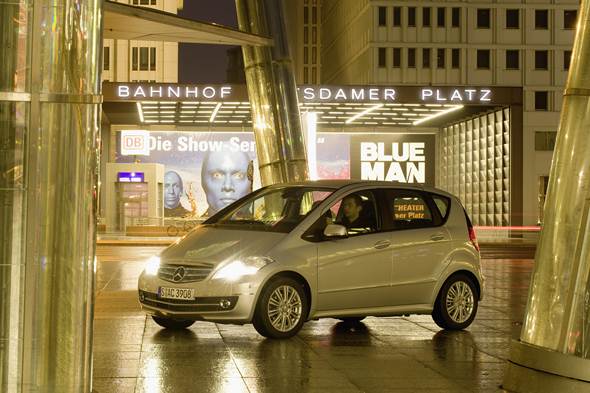
An analysis over a vehicle mileage of 150,000 kilometres shows that CO2 emissions are around seven percent below the figure for the preceding model (W168) of 2004, for example.
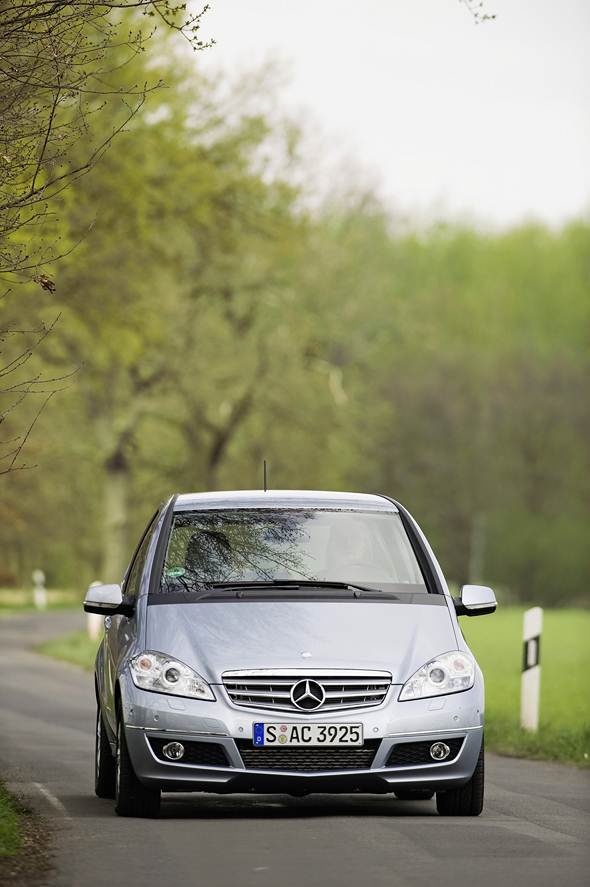
Nitrogen oxide emissions have been reduced by no less than 13 percent.
Even better results are achieved by the A 150 BlueEFFICIENCY with the ECO start-stop function.
Thanks to this new technology, carbon dioxide emissions over the entire lifecycle are reduced by a further five percent, which means that the environmental audit shows a remarkable reduction in CO2 emissions by more than twelve percent compared to the preceding model.
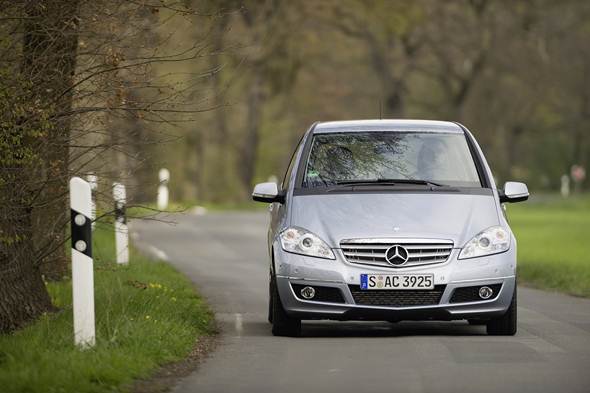
Aspects other than favourable fuel consumption and low exhaust emissions are also important for the environmental certificate.

For example the recycling concept of a vehicle: the A-Class already meets the EU regulation coming into force from 2015, which prescribes a recycling rate of 95 percent.

Plastic components with a total weight of 30.8 kilograms can be produced from highgrade recyclates – twice the figure achieved for the preceding model.

The A-Class also demonstrates its environmentally compatible concept by the use of renewable raw materials.

Mercedes-Benz has various components of the compact car produced with the use of flax, olive stones, cotton, coconut fibre, wood veneers and abaca fibres.

The weight of these components has increased by one third versus the preceding model. Detailed information about environmental audits may be found in a Mercedes-Benz brochure, which is available on the internet at www.media.daimler.com.

Safety: flashing brake lights warn following traffic
The adaptive brake light introduces technology from the luxury class into the compact segment, which therefore benefits from a further accident prevention system as a standard feature.

Under emergency braking from a speed exceeding 50 km/h, the brake lights flash rapidly to warn following traffic, enabling drivers to respond quicker and prevent a collision.

Flashing brake lights are the result of extensive practical research covering the braking behaviour of drivers.

Mercedes engineers found that the braking responses of drivers are on average 0.2 seconds faster in emergency braking situations if a flashing red warning is given in place of conventional brake lights.

The stopping distance can be reduced by around 4.40 metres from a speed of 80 km/h, and even by around 5.50 metres from a speed of 100 km/h.

If the A-Class is brought to a rapid stop from a speed exceeding 70 km/h, the hazard warning system is switched on in addition to the flashing brake lights.

The A-Class sets standards in this market segment where occupant protection is concerned, with two-stage front airbags, belt tensioners in the front and for the outer rear seats, belt force limiters, active front head restraints and head/thorax sidebags.
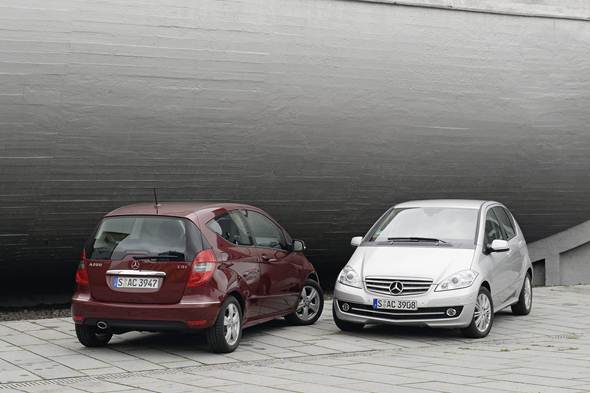
Mercedes-Benz has now added to this extensive safety technology with crash-responsive emergency lighting for the interior.

This is switched on automatically following an accident of a defined severity, providing the occupants with better orientation and facilitating the work of the emergency services.

Parking assist: ultrasound and electric steering for easier parking When finding and reversing into a parking space, drivers of the A-Class will in future be aided by an active parking assist feature which is available on request for all model variants.

Using side-mounted ultrasonic sensors, this system identifies suitable parking spaces on both sides of the road in passing, then informs the driver by means of a display.

The sensors are active up to a speed of 35 km/h, and monitor the area to the left and right of the A-Class.

They measure the length and depth of possible parking spaces, indicating that the search is in progress with a “P” in the instrument cluster.

Once a suitable parking space has been found, an arrow appears in the display to inform the driver on which side of the road the parking space is located.

If he engages reverse gear, acknowledges the display message and accelerates, active parking assist takes over the steering and automatically manoeuvres the car into the parking space.

The driver only needs to accelerate and operate the brakes; the ultrasonic sensors of the PARKTRONIC system assist him in this by keeping him informed about the distance to the vehicle in front of and behind the A-Class.

Active parking assist uses a total of ten ultrasonic sensors in the front and rear bumpers, as well as an electronic control unit which processes the sensor signals and calculates the best possible entry path into the parking space.

This information is fed to the electromechanical power steering, whose electric motor performs the necessary steering movements of its own accord.
The parking space only needs to be 1.30 metres longer than the A-Class for this automatic parking procedure to take place – an indication of the great precision of this technology.

Thanks to its very compact dimensions, a parking space with a length of just 5.18 metres or so is sufficient; there is currently no other car able to park automatically in such a small space.
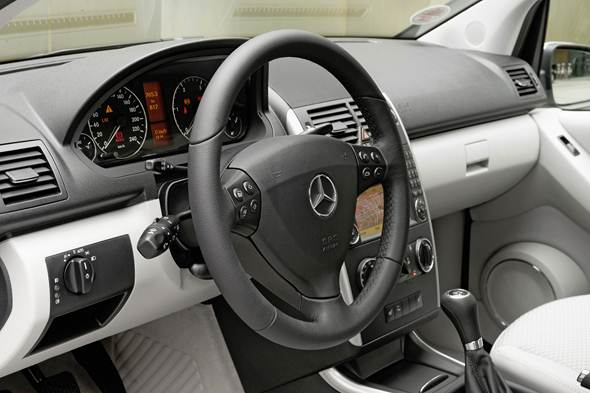
Mercedes engineers have also added a new function to a well-proven support system: the Electronic Stability Program (ESP®) of the A-Class now has an automatic hill-holder function which prevents the car from rolling backwards when the driver changes from the brake pedal to the accelerator when moving off on an uphill gradient.

In these situations ESP® maintains the brake pressure for a short time, so that the driver can move off smoothly.

Audio: new units offer Bluetooth, a colour display and Europe-wide navigation
Like all the new 2008 Mercedes models, the A-Class is available with further improved information, communication, navigation and entertainment systems – in other words infotainment.
There is a choice of four optional head units: Audio 5, Audio 20, Audio 50 APS and COMAND APS.
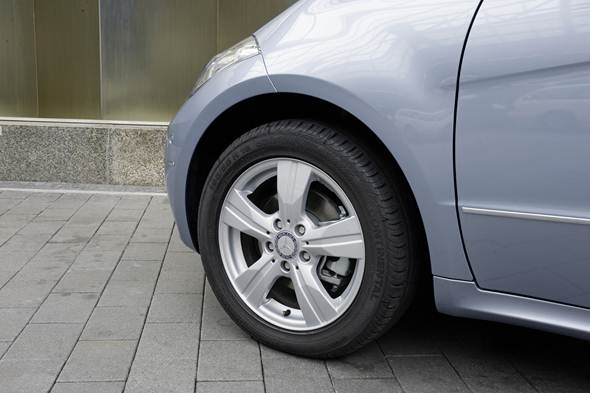
From Audio 20 these ncorporate a radio with twin tuner, colour display, a Bluetooth interface for a mobile phone, a telephone keypad, a CD-player, automatic volume adjustment and a connection for external audio units in the glove compartment.

Audio 50 APS is also equipped with a Europe-wide DVD navigation system and a DVD drive, while the top-of-the-range COMAND APS features HDD navigation, a music register, a slot for SD memory cards and voice control.
The LINGUATRONIC system operates the telephone, audio and navigation system by convenient whole-word commands.

The driver need no longer spell out his wishes, but simply needs to say what he wants when entering a destination, selecting a radio station or accessing an entry in the telephone directory.
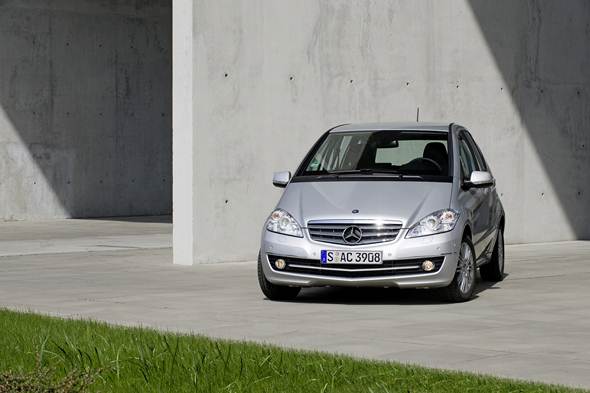
Interface: the “iPod” can be operated via the keys on the steering wheel
More scope for mobile musical enjoyment is provided by a newly developed, interactive media interface, which is able to connect an MP3-player, USB stick or other external audio unit with the infotainment system of the car.

This means that external audio units can be conveniently operated using the keys on the multifunction steering wheel, while the titles of music tracks are shown in the instrument cluster and on the colour display in the centre console.

While the portable audio unit is connected to the car via the media interface, its battery is charged. Connection of an iPod or similar requires a suitable cable which is available from the Mercedes-Benz accessories range.

The award-winning “Logic 7®” surround sound system, which celebrated its world premiere in the S-Class, is also available for the A-Class.
The system has an output of 450 Watts and features twelve loudspeakers (Coupé: ten).

Model facelift changes at a glance (Selection)
New features in the A-Class
Design
• Front end: redesigned headlamps, radiator grille and bumper
• Side aspect: redesigned exterior mirrors and wheels
• Rear end: redesigned tail lights and bumper
• Interior: new upholstery fabrics
Equipment
• AVANTGARDE with new decorative trim
• Exterior mirror housings and door handles painted in vehicle colour
• Headlamp assist and luggage cover as standard
• ESP® with automatic start-off assist
• Ambient and warning lights in the tailgate
Safety
• Adaptive, flashing brake lights
• Crash-responsive emergency lighting as standard in the interior
Drive
• ECO start-stop function optional for A 150 and A 170
• A 160 CDI Coupé with BlueEFFICIENCY package
Technology
• Active parking assist as an optional extra
• New infotainment units with many additional functions
• Surround-sound system on request
• COMAND APS with HDD navigation and voice control
• Interactive media interface for external audio units on request


Equipment
More perceived value all-round
• Choice of two body versions and seven engines
• Standard appointments significantly upgraded
• Two equipment lines with a decidedly individual character
Since 1997 the A-Class has self-confidently and emphatically shown itself to be a cut above other compact cars, and set standards in safety, practicality and reliability.
To date around 1.7 million customers worldwide have been convinced by these and the many other qualities.
More than half of these are new Mercedes customers – clear testimony to the great attractiveness of this vehicle.
In numerous respects the new-generation A-Class is now a more attractive proposition. Its design, equipment, technology, economy and environmental compatibility have been improved further, which means that the best and also most innovative A-Class ever is making its debut in spring 2008.
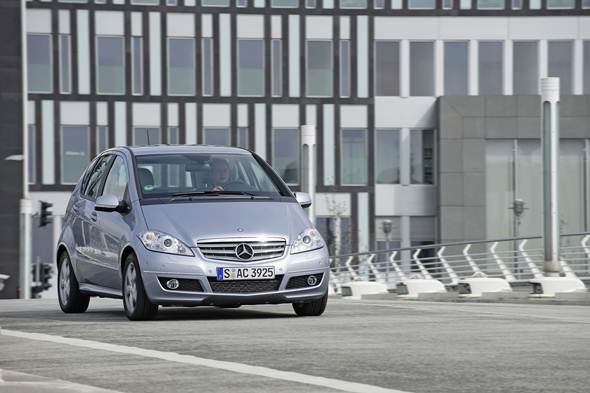
Individuality continues to be another hallmark of this model, with a choice of two body versions designed to appeal to different customer groups: the five-door A-Class with its great day-to-day variability and practicality, and the three-door Coupé which adds a special youthful and sporty appeal to the outstanding safety and comfort attributes.
Further options to realise individual wishes are offered by the ELEGANCE and AVANTGARDE design and equipment lines, as well as by special equipment packages and optional extras.
As before, the A-Class is available with a choice of seven four-cylinder engines which are combined with a five or six-speed manual transmission, depending on the level of torque. The variable AUTOTRONIC transmission is available on request.

The output range of these engines extends from 60 kW/82 hp to 142 kW/193 hp. With a fuel consumption of 4.5 to 8.1 litres per 100 kilometres (combined NEDC consumption), these four-cylinder units are among the most economical engines in their displacement and output classes.
New driver support systems as standard equipment The A-Class is distinctly superior to other compact cars where safety and comfort features are concerned.
The standard appointments already include adaptive front airbags, head/thorax sidebags, adaptive belt force limiters, crash-responsive front head restraints, a multifunction steering wheel, speed-sensitive power steering (parameter steering), a selective damping system and air conditioning.

Now Mercedes-Benz has extended this large range of features with more standard equipment and new driver support systems which further enhance both safety and comfort:
• Larger-capacity stowage compartment between the front seats
• Exterior mirrors painted in the vehicle colour
• Hill-holder
• Adaptive, flashing brake lights
• Crash-responsive emergency lighting
• Cupholder in a new design
• Power windows with one-touch control
• Headlamp assist
• Luggage cover
• Wheel embellishers in a new design
• Upholstery fabrics in a new design
• Door handles painted in the vehicle colour
• Ambient and warning light in the tailgate
ELEGANCE and AVANTGARDE with even more individual features The ELEGANCE and AVANTGARDE lines are highlighted by additional comfort and design features.
The features introduced with the model facelift include the following in addition to the basic model:
• Oval exhaust tailpipe of polished stainless steel
• Chrome trim strip above the side skirts
• Front apron with chrome insert, in a distinctive design for the
AVANTGARDE line
• Rear bumper with chrome inserts and reflector-look, additional black insert for the AVANTGARDE line
• 16-inch light-alloy wheels in a 10 twin-spoke design (ELEGANCE) or five-spoke design (AVANTGARDE)
• Leather-lined steering wheel
• Foglamps with chrome surround
• Seat upholstery in fabric and ARTICO man-made leather
• Luxury seat package with front seat cushion angle adjustment, front lumbar supports and height-adjustable front passenger seat
• Myrtle wood trim (ELEGANCE) or diagonally brushed aluminium trim in smoke-silver (AVANTGARDE)
New optional extras for more economy and comfort
The list of available optional extras continues to include high-tech systems which are by no means to be expected in this vehicle class.
For example the newly developed infotainment units, which boast a colour display, Bluetooth interface, telephone keypad and a connection for external audio units depending on the model.
The new top-of-the-line Audio 50 APS and COMAND APS units also have additional functions such as Europe-wide navigation and a DVD drive. COMAND APS is also equipped with a voice control system as standard.
Another outstanding technical highlight is the new active parking assist, which helps the driver to reverse into parking spaces and carries out all the necessary steering movements automatically.
The newly developed optional extras for the A-Class at a glance:
• Active parking assist
• Audio 20, on request also with an integrated 6 CD-changer
• Audio 50 APS with Europe-wide DVD navigation, on request with an integrated 6 DVD-changer
• COMAND APS with HDD navigation and map display
• ECO start-stop function (for A 150 and A 170 with manual transmission)
• LINGUATRONIC voice control with whole-word commands
• „Logic7®“ surround-sound system
• Media interface for external music units
A number of optional extras are also included in the attractive equipment packages which Mercedes-Benz has put together for the A-Class.
These are the Light and Sight Package, the Sports Package and the new Selective Package. This includes a leather interior, electrically adjustable front seats with heating and the THERMOTRONIC automatic climate control system.

Design
Assured presence
• New front-end design conveys superiority and dynamism
• Additional design features emphasise the individuality of the lines
• Careful detailed improvements enhance the perceived value of the interior
Short and practical – that was the succinct motto with which Mercedes designers embarked on a completely new challenge in the mid-1990s.
The aim was to design an automobile whose unique bodyshell concept demanded equally original design ideas: the A-Class.
The fact that the designers came up with the right ideas is demonstrated by the success of this Mercedes compact car, whose design lines continue to reflect its essential character: youthful, progressive and dynamic.

For the new A-Class, which was presented to the public for the first time in spring 2008, the successful one-box design has been improved upon in a number of details.
The aim was to emphasise the presence and superiority of this compact car with tighter, more striking body contours.
This was mainly achieved by a revised front-end design with new headlamps, an even more imposing front bumper and a modified radiator grille.
The bumper of the A-Class has a pronounced arrow-shape as a characteristic feature of the Mercedes design idiom.
This unmistakably conveys attributes such as forward-flowing energy, performance and agility.
It is matched by the sharper contours of the front bumper and its enlarged lower air intake, which emphasises the width of the body and lends it a more muscular appearance.
The radiator grille is more striking than before, and an eye-catching central feature of the front end.
The headlamps, bumper, radiator grille and bonnet form an extremely harmonious unit which reflects the greatest precision in both formal and technical terms.
In other words, everything appears to be cast from a single mould.

Clearer distinction between the lines Redesigning the front end provided the opportunity to emphasise the appearance of the lines more clearly, thereby underlining the individual characters of the ELEGANCE and AVANTGARDE models more emphatically.
While the lines were previously distinguished mainly by the design of the radiator grille, the front bumper and lower cooling air intake now also act as distinguishing features:
- In the basic model the louvres in the radiator grille are in dark-grey, and the lower air intake in the bumper is divided by a cross-piece painted in the vehicle colour.
- In the ELEGANCE line the louvres of the radiator grille are painted in metallic atlas grey, with slim chrome trim strips on the leading edges. The bumper is likewise embellished with chrome inserts, and the foglamps in the bumper’s lower air intakes have chrome surrounds.
- In the AVANTGARDE line Mercedes-Benz paints the louvres of the radiator grille in iridium silver, emphasising this decidedly elegant look with additional chrome trim strips on the leading edges of the louvres.

The front bumper has a distinctive design which emphasises the arrow-shape of the front end. The prominent lower air intake is subdivided by two angled sections.
Discreet chrome trim strips and chrome surrounds on the foglamps further enhance the overall appearance.
Elegant side aspect
The A-Class is more elegant than before when viewed from the side, and mainly for two reasons: firstly because the exterior mirror housings and door handles in all lines are painted in the vehicle colour, and secondly because the designers have dispensed with the previous side rubbing strips, which are replaced by fine chrome trim strips in the ELEGANCE and AVANTGARDE models.
The wheel embellishers and light-alloy wheels have also been redesigned. The basic model now has a 7-spoke wheel embellisher, while the two lines are shod with eyecatching 16-inch light-alloy wheels in a 10 twin-spoke design (ELEGANCE) and 5-spoke design (AVANTGARDE). The light-alloy wheels are painted in titanium silver.
Powerful highlights at the rear The new-generation A-Class is also significantly different from the preceding series when viewed from the rear.
The rear bumper, tail lights and exhaust tailpipe are in a new design which further emphasises the width of the body to ensure a more muscular appearance.

The designers achieved this by reshaping the rear light clusters, whose height has been reduced. As a result they blend into the rear-end design more harmoniously, ensuring an attractive visual transition to the vehicle flanks.
At the rear end, discreet design features serve to differentiate between the lines:
• In the basic model, the redesigned and ergonomically improved handle of the tailgate is in black.
• The tailgate handle is chrome-plated in the ELEGANCE line. In addition the rear bumper is upgraded by a reflector-look at both ends, and the oval exhaust pipe has a stainless steel tailpipe.
• In the AVANTGARDE line the lower section of the rear bumper is distinguished by a black centre section. Standard features also include a chrome-plated tailgate handle, the reflector-look and polished stainless steel exhaust tailpipe.
New fabrics, colours and trim elements in the interior
The first impression when entering the A-Class is one of generous spaciousness. In addition to large window surfaces, this is ensured by a harmonious design and colour concept which lends the interior a bright, friendly and yet dramatic atmosphere. A high value impression results from the use of first-class materials and a very high standard of finish.

For the new-generation, Mercedes designers have selected new, high-grade upholstery fabrics and door linings which emphasise the homely interior atmosphere. The upholstery fabrics for the basic model are available in singletone black and orient beige, or in a combination of black/multicolour.
In the ELEGANCE and AVANTGARDE lines the seats impress with an elegant combination of ARTICO man-made leather and fabric available in a choice of three colours: black, orient beige and alpaca grey.
The centre console is attractively bordered by vertical trim strips.
In the basic version these border strips are in shining black plastic of high quality, while the ELEGANCE line has trim strips of fine myrtle wood and the AVANTGARDE line a sporty trim of smoke-grey, diagonally brushed aluminium.
The inner door panels are also embellished with trim strips made from these materials.
A leather-lined steering wheel, chrome surrounds on the door loudspeakers, a leather-lined shift lever and parking brake lever and the new luxury seating package are further features of the ELEGANCE and AVANTGARDE models.
All variants of the A-Class share a larger stowage compartment in the centre console and a newly designed cupholder between the front seats.

Technology
Innovations for the environment, safety and comfort
• Fuel consumption lowered by more than eight percent
• A 160 CDI BlueEFFICIENCY with 119 grams of CO2 per kilometre
• Comfortable ECO start-stop function for A 150 and A 170
• Parking assist for automatic reversing into parking spaces
• Infotainment units with Europe-wide navigation
The A-Class remains true to its role as a technological trendsetter. Mercedes engineers have developed new systems for this compact car that bring major progress in important areas – notably safety, comfort, economy and environmental compatibility.
One major aspect is the further reduction of fuel consumption and carbon dioxide emissions. Mercedes-Benz has thoroughly re-examined the car, and achieved remarkable results by making detailed improvements: compared to the previous series, the new-generation A-Class consumes around eight percent less fuel per 100 kilometres.

The Mercedes hit-list of particularly economical models is headed by Coupé version of the A 160 CDI, which is equipped with a new BlueEFFICIENCY package as standard.
This reduces the NEDC fuel consumption of the three-door car to 4.5 litres per 100 kilometres, which is 0.4 litres below the previous figure. CO2 emissions are nine grams lower at 119 grams per kilometre.
BlueEFFICIENCY is the new trademark for particularly economical and environmentally compatible Mercedes passenger cars.
Mercedes engineers have utilised the potentials from various development areas to reduce fuel consumption even further by means of lightweight construction, a lower air and rolling resistance and more efficient energy management.
In the A 160 CDI BlueEFFICIENCY, it is particularly the aerodynamic measures and demand-related control of the generator that make themselves felt in terms of fuel consumption:
• The suspension has been lowered by ten millimetres, thereby exposing a smaller frontal area to the airstream.
• The inner surface of the radiator grille is enclosed, reducing the volume of air flowing into the engine compartment. This significantly reduces the drag coefficient, but has no negative effect on engine cooling.
• The generator of the A 160 CDI BlueEFFICIENCY is controlled according to demand, and therefore effectively contributes to fuel economy.
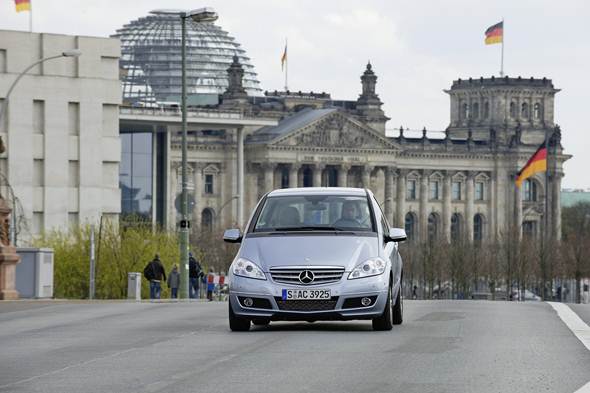
This energy management is based on sensor information about the battery’s charge status. If it has a sufficient charge, the output of the generator is reduced for certain periods.
This reduces the work required of the CDI engine, which therefore consumes less fuel. To recharge the battery the system utilises the engine’s overrun phases, and therefore its braking energy, which is converted into electrical energy by recuperation.
The three-door A 160 CDI BlueEFFICIENCY is available with a five-speed manual transmission from autumn 2008.
Fuel savings of up to nine percent with the ECO start-stop function During the design and development of their BlueEFFICIENCY measures, the Mercedes specialists were primarily guided by the actual user behaviour of Mercedes customers as identified by a large-scale practical analysis.
These data covering the day-to-day operating conditions and profiles of Mercedes car models have shown that the A-Class is predominantly used for short and medium-range journeys with frequent traffic light stops, stop-and-go traffic and tailbacks.

Accordingly Mercedes-Benz has developed a technology which offers significant fuel consumption advantages in such traffic situations: the ECO start-stop function.
From autumn 2008 this will be optionally available for the high-volume models A 150 and A 170 equipped with the five-speed manual transmission, which will also receive the BlueEFFICIENCY hallmark thanks to this technology.
The ECO start-stop function lowers fuel consumption and exhaust emissions by automatically switching off the engine during idling phases.
The driver is informed by a special display in the instrument cluster if and when the conditions for engine switch-off are met.
When travelling at low speed, he only needs to shift the manual transmission to neutral and apply the brakes. The engine is then switched off, and the ECO display appears in the instrument cluster.

The ECO start-stop function demonstrates its superiority over other systems of this kind when restarting the engine. This process is not only very fast, but also particularly quiet when the driver operates the clutch or releases the brakes.
This is the major advantage of the newly developed starter generator, which is directly integrated into the engine’s belt drive and powers the crankshaft — much quicker and quieter than with the conventional starter.
During a journey the starter generator acts as an alternator and feeds electrical power to the onboard network.
An intelligent control system ensures that the battery is only recharged when necessary, with particular use of the engine’s overrun phases when braking energy can be converted into electrical energy by recuperation.
The ECO start-stop function features an electronic control unit which adapts the functions of the system to the operating conditions of the A-Class.
This means that the engine is not switched off at low or very high ambient temperatures, so that the heating or air conditioning continue to operate at their full efficiency.
Mercedes-Benz has subjected the ECO start-stop function to extensive practical trials in which around 175 test cars covered approx. 1.2 million kilometres.
The comfortable ECO startstop function is based on a starter generator integrated into the engine‘s belt drive
Roughly half of these journeys were in city traffic, where the new system offers impressive advantages: fuel savings of up to nine percent and a reduction in NEDC fuel consumption by around 6.5 percent.
The A 150 BlueEFFICIENCY consumes 5.8 litres per 100 kilometres, which makes it 0.4 litres more economical than the A 150 without the ECO start-stop function.
In the case of the A 170 BlueEFFICIENCY the fuel saving is 0.5 litres per 100 kilometres. Choice of seven up-to-date four-cylinder engines.

Extended safety features including emergency interior lighting Safety is another major attribute of the Mercedes-Benz A-Class.
In addition to the unique body concept, which offers advantages in the event of a frontal or side impact, an effective seat belt and airbag system provides the level of occupant safety typical of a Mercedes.
This includes adaptive, two-stage front airbags, belt tensioners in the front and for the outer rear seats, and adaptive belt force limiters and head/thorax sidebags in the front.
The use of high-strength steel alloys, extremely strong bonded connections and robust structural members in the bodyshell also ensures that the occupants are well protected even during a serious accident.
Mercedes-Benz has supplemented this extensive range of safety features with an emergency interior lighting system which is switched on automatically following a serious collision.
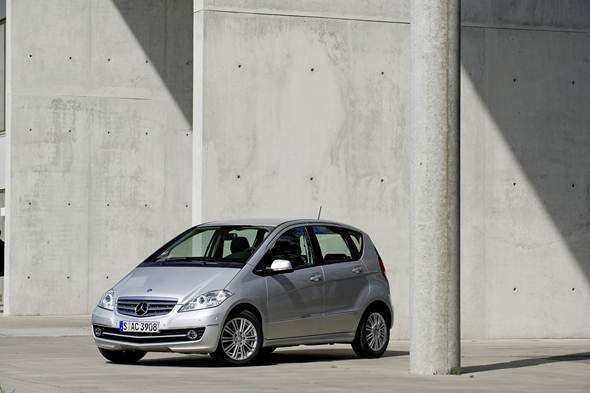
This provides the occupants with better orientation at night, and facilitates the work of the emergency services when recovering injured passengers.
Dimensional concept: the modified front and rear design increases the length of the A-Class by 45 millimetres. The interior space remains unchanged.
Flashing brake lights as an effective warning when danger threatens In the field of active safety, the A-Class benefits from the technological leadership of the Mercedes models in the luxury and super-luxury class.
In addition to ESP®, Brake Assist and other systems which make driving safer and demonstrably contribute to accident prevention, Mercedes-Benz is now equipping the A-Class with a new development that is able to lower the risk of rear-end collisions: flashing brake lights.

This invention is based on the findings obtained from accident research, which show that three quarters of all serious traffic accidents could be avoided if drivers were given a clear warning of potential danger at an early stage.
Mercedes engineers therefore developed the flashing brake light system and tested its effectiveness during practical trials.
These showed that the braking response times of drivers are reduced by an average of up to 0.2 seconds if a flashing red warning signal is given instead of conventional brake lights in an emergency braking situation.
As a result the stopping distance of the vehicle behind is reduced by around 4.40 metres at a speed of 80 km/h, and even by around 5.50 metres at 100 km/h.
Flashing brake lights are therefore an effective means of preventing rear-end collisions. Thanks to this technology now included as standard, driving is therefore also made safer for those not travelling in a Mercedes-Benz.
Mercedes specialists tested various warning lights during the course of this study. Brake lights that flash more rapidly than the hazard warning lights during emergency braking proved to be particularly effective in warning following traffic of an impending rear-end collision.
The Mercedes study also revealed that switching on the hazard warning system in a critical situation has only an insignificant effect on the reaction time of other drivers.
Automatic parking with ultrasound Newly developed driver support systems and functions not only make travel in the A-Class even safer, but also more comfortable.
For example, Mercedes-Benz have enhanced the Electronic Stability Program with a new, standard function aimed at increased comfort: the automatic hill-holder.
This prevents the car from rolling backwards when the driver changes from the brake pedal to the accelerator when moving off on an uphill gradient. In these situations ESP® maintains the brake pressure for a short time, so that the driver can move off smoothly.

Finding and reversing the A-Class into a parking space is also made easier and more convenient with the newly developed, optional parking assist system, which uses ten ultrasonic sensors.
These sensors are active up to a speed of 35 km/h, and monitor the area to the left and right of the A-Class, measuring the length and depth of possible parking spaces.
A “P” symbol in the instrument cluster informs the driver that this electronic search for a parking space is in progress.
Once a suitable parking space has been found, an arrow appears in the display to inform the driver on which side of the road the parking space is located.
Now the driver only needs to stop, engage reverse gear and confirm his acceptance of the recommended parking space by pressing a key on the multifunction steering wheel.
As soon as he operates the accelerator, active parking assist takes over the steering and automatically manoeuvres the car into the parking space.
The driver only needs to accelerate and operate the brakes; the ultrasonic sensors of the PARKTRONIC system assist him in this by keeping him informed about the distance to the vehicle in front of and behind the A-Class.
Finding a space: Ultrasonic sensors measure the length and depth of parking spaces on both sides of the road Parking: Active parking assist steers the A-Class into the parking space, while the driver merely accelerates and brakes
The ten ultrasonic sensors in the front and rear bumpers send their information to an electronic control unit, which not only measures the size of the parking space but also calculates the best possible entry path.
The data are fed to the electromechanical power steering of the A-Class, whose electric motor performs the necessary steering movements of its own accord.
Active parking assist enables drivers to use suitable parking spaces which they would normally consider too small and pass by.
This is because the parking space only needs to be 1.30 metres longer than the A-Class for this automatic parking procedure to take place – an indication of the great precision of this technology.
Thanks to the compact dimensions of the A-Class, a parking space with a length of just 5.18 metres or so is sufficient. New infotainment units for a digital music experience Information, communication, navigation and entertainment – four terms which are nowadays just as important to drivers as e.g. agile handling, a high standard of comfort or a powerful engine.

Nobody wants to be without news, telephone, route guidance or musical enjoyment, even in the car.
Accordingly these topics enjoy a very high priority during the development of new Mercedes models. The engineers in Sindelfingen have developed new systems for the A-Class which bring cutting-edge technology from the luxury class to the compact class.
There is a choice of three new units, all of them with a colour display, a twin or triple tuner for superior radio reception, speed-sensitive volume control, a keypad for entering telephone numbers and radio frequencies, a connection for external audio units and a Bluetooth interface that wirelessly connects a mobile phone to the onboard hands-free system.
- Audio 20 with CD-player This car radio with an integral CD-player (MP3-capable) includes an FM/ MW, AM and LW tuner with automatic station search, RDS (during FM reception), direct frequency input via the keypad in the centre console and a 5-inch colour display.
- Audio 50 APS with DVD navigation This infotainment system combines a car radio, telephone exchange and Europe-wide DVD navigation system in a single head unit. The route guidance information – with zoom function – is arrow-based and appears on a 5-inch colour display. The integral DVD drive can be used for navigation or audio data. If the optional 6 DVD-changer is specified, Audio 50 APS also includes the improved LINGUATRONIC voice control system with whole-word commands.
- COMAND APS with HDD navigation and music register This multimedia system has a Europe-wide navigation system whose data are stored on a hard disc (40 gigabytes), allowing particularly fast access to the navigation data and faster route calculation.

The route map is shown on a 6.5-inch, high-resolution colour display. COMAND APS also includes a music register with a memory capacity of four gigabytes.
This enables the driver to store around 1000 music tracks in the MP3 format from CDs, DVDs or memory cards.
The system automatically recognises the titles and performers, and shows them on the colour display. Above the colour display the unit has a slot for SD memory cards which can also be used to store music files.
COMAND APS also features voice control as standard, and a 6 DVD-changer is available on request.
The Audio 5 car radio with its familiar functions and features remains part of the range available for the A-Class.
Interactive interface for an iPod etc. Equipping COMAND APS with a music register and memory card slot shows that entertainment was an important aspect during the development of the new audio units: Mercedes customers are able to compile their own musical playlist and take it with them on an SD card.
Now an iPod, USB stick or other external audio unit can also be connected to the onboard infotainment system of the A-Class.
A newly developed universal media interface available ex factory for all the infotainment systems makes this possible.
All that is required is a suitable cable which is available from the Mercedes accessories range.
This interface is much more than just an electronic “socket” in the glove compartment.
The new technology also includes a control unit that connects the external music files with the onboard electronics and operating system of the A-Class.
This means that the music stored in an iPod is also displayed in the instrument cluster and the colour display in the centre console, and can be conveniently selected using the keys on the multifunction steering wheel.
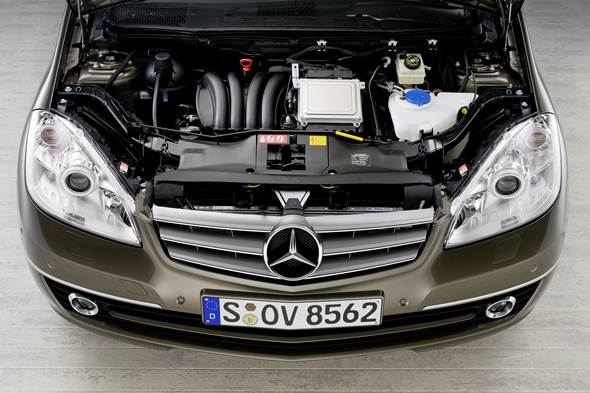
While the portable audio unit is connected to the onboard system via the media interface, its battery is also charged.
The ultimate musical enjoyment is guaranteed if the optional “Logic7®” surroundsound system is ordered.
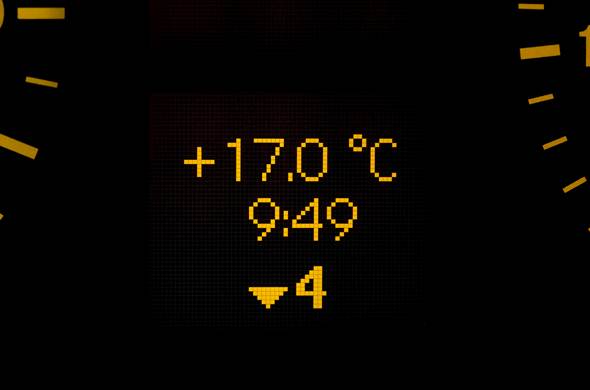
This offers a natural 360-degree sound experience for all the occupants – a concert hall on wheels.
It makes no difference whether the music source is a DVD or CD, or whether the recording is in Dolby 5.1 Surround or normal stereo.

The music signals are distributed via twelve loudspeakers (Coupé: ten) and a 450-watt amplifier.
Voice control with whole-word commands Voice control is standard equipment in the A-Class if Mercedes customers specify Audio 50 APS with a 6 DVD-changer or the COMAND APS multimedia unit.

LINGUATRONIC operates the telephone, audio and navigation systems particularly conveniently by whole-word commands.

This means that the driver need no longer spell out his commands, but merely has to say what he requires when entering a destination, selecting a radio station or choosing a name from the stored telephone directory.
During this brief dialogue the sound signal is digitised, converted into a frequency range and analysed.
Within milliseconds the computer identifies various characteristics of the voice signal and recognises what are known as the phonemes or linguistic components.

The electronics rapidly check each sound, join the different phonemes together, compare them with the contents of a stored phoneme dictionary and ascertain the acoustic probability of the word.
This enables the system to recognise even very minor differences in pronunciation, e.g. between the words “Town” and “Down”. The phonemes of six different languages are stored in the system.

With LINGUATRONIC Mercedes-Benz makes an important contribution to traffic safety, as the driver no longer needs to take his hands off the wheel to operate the telephone or audio equipment.
His workload is reduced and he is better able to concentrate on the traffic situation.

In 1996 Mercedes-Benz was the first automobile brand to offer such an onboard system. The first-generation LINGUATRONIC system only required a processor with a memory capacity of 512 kilobytes, but more than ten megabytes are now needed for the greatly increased capabilities of the voice control system.

A-Class Special Edition 2009
Excitingly sensible, sporty and attractive
Stuttgart – Mercedes-Benz is ushering in the spring with a new special model of the A-Class.
With design features reserved only for this edition, plus extensive, high-grade appointments, the Special Edition 2009 is not only eye-catching.
It also combines the well-proven basic virtues of this compact Mercedes-Benz model with more than a touch of passion.
This exclusive new model variant in the A-Class is available now.

To date the A-Class with its distinctive and versatile concept has captured the hearts of around 1.8 million customers.
The strengths of this true trendsetter above all include a generous, variable interior despite compact external dimensions, a high level of reliability, impressive safety and environmentally friendly engines.
The new special model in the A-Class has an emotionally appealing, enhanced appearance for a combination of the excitingly sensible with the sporty and attractive.

The unmistakable, striking appearance of the special model is characterised by exclusive features such as the black radiator louvres, 16-inch titanium silver light-alloy wheels in a new 9-spoke design (tyre size 195/55 R16) and a “Special Edition” badge on the mirror triangle.
Standard exterior features also include fog lamps and a free choice of metallic paint finish.

In the interior, the special status of the Special Edition 2009 is emphasised by a two-tone colour scheme in black and grey, carefully finished, high-grade materials and stylish features.
These include dedicated, shiny black trim with a pattern and black velour floor mats with grey edging and an embroidered Edition label.
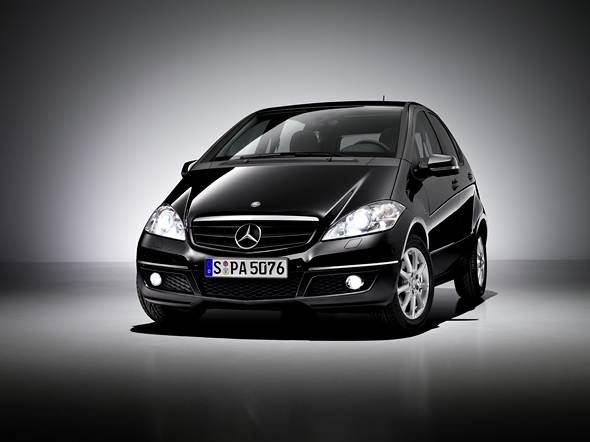
The multifunction steering wheel, shift/selector lever and parking brake handle are lined in leather.
The appointments also include an Audio 20 radio with CD player and Bluetooth hands-free system and the Light and Sight package with a rain sensor, automatically dimming rear-view mirror, an illuminated vanity mirror in

the sun visor, separately adjustable reading lights in the rear, a reading light for the driver and illuminated front footwells.
A Seating Comfort package is also standard equipment, with a height-adjustable front passenger seat, seat cushion angle adjustment and lumbar supports for the driver and front passenger.

The extensive standard appointments of the new special model amount to a price advantage of 36 percent.

The advantages of the Special Edition 2009 are available for all model variants of the A-Class.
Including the versions equipped as standard with the BlueEFFICIENCY package, which e.g. further improves engine efficiency, aerodynamics, rolling resistance, energy management and weight in the A 160 CDI BlueEFFICIENCY saloon.
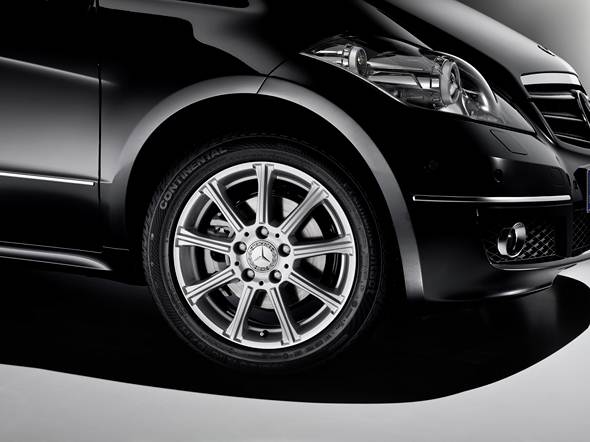
With an output of 60 kW/82 hp, it consumes only 4.5 litres of fuel per 100 kilometres, with CO2 emissions of 119 grams per kilometre.
The A-Class is also the first compact car to have been awarded an environmental certificate according to the stringent, international ISO standard 14062.

The new Special Edition 2009 of the A-Class is a limited edition of 5 500 units.


